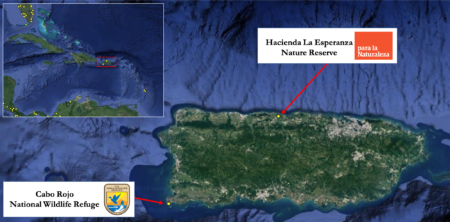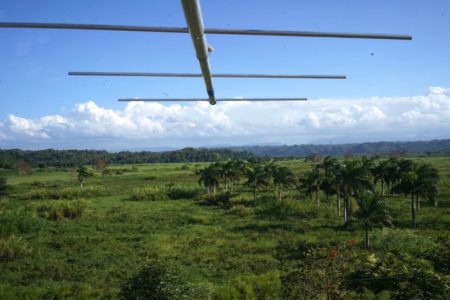In March 2022, we installed the first two Motus stations that are part of BirdsCaribbean’s effort to expand the Motus network in the Caribbean region. Three installation experts from the Northeast Motus Collaboration and 12 trainees came together in Puerto Rico to put up stations at Cabo Rojo National Wildlife Refuge and Hacienda La Esperanza Nature Reserve.
The rumors are true – Motus stations in the Caribbean are growing! It took months of hard work and preparation but, during the week of March 22-29, 2022, a team of Motus experts and novices interested in the installation of Motus stations successfully added two more stations (and two more dots) to the Motus Wildlife Tracking System.
“It was so satisfying to watch those tiny yellow dots appear on the Motus station map,” commented Maya Wilson, Project Manager for the Caribbean Motus Collaboration, noting that the Caribbean region greatly needs more tracking stations.

But what is Motus, and why is it important?
Motus (Latin for movement) is a powerful research network that uses automated radio telemetry to track the movements of small flying animals. The power of Motus lies in its collaborative nature, combining hundreds of projects that have installed 1400+ receiver stations and deployed nearly 34k+ tags on 287 species, mostly birds. Adding receiving stations in the Caribbean is critical, since the region is an important migratory pathway and overwintering region for many bird species.
Motus is one of three monitoring networks that we are aiming to build in the Caribbean as part of our new Landbird Monitoring Project. But with growing interest in Motus in the region, we’ve expanded our efforts into the Caribbean Motus Collaboration (CMC).
Expanding Motus in the Caribbean
Our timely development and implementation of the CMC has been possible largely due to our ongoing partnership with the Northeast Motus Collaboration (NMC). The NMC has put up around 120 stations over the last several years (with plans to reach 150 by the end of the year!), and they have been generously sharing their knowledge with us. Recently, Lisa Kizuik and Todd Alleger presented in our webinar series to provide an introduction to Motus and plans for the Caribbean, and some guidance on how to plan your Motus station.
First stop – Puerto Rico!
To kick things off, we traveled to southwestern Puerto Rico to install a station at Cabo Rojo National Wildlife Refuge. This station is the result of a partnership with the U.S. Fish and Wildlife Service’s National Wildlife Refuge System, adding to the larger network of stations on National Wildlife Refuges.
We gathered at the Centro Interpretativo Las Salinas, where visitors to the refuge can see and learn about the legendary salt flats. Most of us had never assembled yagi antennas or deployed a SensorStation before. But lucky for us, three experts from the NMC – Todd Alleger, Mallory Sarver, and Aaron Coolman – led the team through each step.
As a base for the station, a telescoping mast was bracketed to the corner of a building on the refuge. The six antennas (3 of each frequency) were assembled, coaxial cables were attached and labeled, and then each one was hoisted up the ladder to be attached to the mast. The coaxial cables were run through a slatted window to be connected to a SensorStation housed inside. The next day, we returned to add some extra concrete support to the base of the station, add a grounding rod, and deploy the SensorStation. With that, the first station was up – constantly listening for tagged birds on the salt flats, dry forest, mangroves, and other important bird habitats throughout the refuge.
One down… One to go!
From Cabo Rojo, we headed to Puerto Rico’s northern coast to install another station at Hacienda La Esperanza Nature Reserve. In partnership with Para La Naturaleza (PLN), this station is the first of several stations that will be installed as part of our Landbird Monitoring Project. Attached to the recently rebuilt sawmill building on the reserve, the station will detect any tagged birds moving through or within the karst and coastal forests, wetlands, fields, and other habitats.

The main structure for this station is a 30-ft Rohn tower, which meant that we had to start by making sure that the base was solid. PLN had already built a wooden cast for the cubic yard of concrete that we had to mix and pour in around the Rohn base. Once the cast was leveled in its place and the 5-ft Rohn section was stabilized, the concrete mixing began. Rotating through team members, we made relatively quick work of the 48 60-lb bags in the bucket of a tractor. As a final natural touch, we pressed leaves and flowers into the concrete.
Teamwork definitely made this dream work!
While the concrete started drying, we assembled the 8 antennas (4 of each frequency) and coaxial cables in preparation for the tower assembly the following day.
The next morning, we started by putting the three 10-ft Rohn sections together, then carefully raised the tower and lifted it onto the base. Once the tower was bracketed to the building, Todd climbed to the top and we began passing him the antennas. After a couple more hours of hard work in the hot Puerto Rican sun, the antennas were attached, and the coaxial cables were securely run into the top level of the building where they were connected to the SensorStation.
The CMC is just getting started – we may be in your island soon!
Now that both stations are officially on the Motus station map, we are eagerly watching them to see which tagged birds visit or travel through these areas! But this is only the beginning – the excitement and momentum behind the Caribbean Motus Collaboration is still going strong. Just over the next year or so, you can expect to see many other stations pop up in Barbados, The Bahamas, Dominican Republic, Jamaica, the Cayman Islands, Saba, and several other Caribbean islands.
To find out more about the CMC and or to let us know if you are interested in contributing, please contact Maya Wilson at Maya.Wilson@BirdsCaribbean.org.
Acknowledgments: We want to say thank you to the Northeast Motus Collaboration for their constant help and support. Special thanks to Todd Alleger, Mallory Sarver, and Aaron Coolman for leading us through our first CMC installations! We are grateful to our partners in Puerto Rico, the U.S. Fish and Wildlife Service, and Para La Naturaleza, particularly Adam Smith, Ricardo Antonetti, and Alcides Morales, for helping us plan, install, and watch over these stations. Thanks to our funders, the U.S. Fish and Wildlife Service’s Neotropical Migratory Bird Conservation Act grant, and our generous supporters who have donated to the Caribbean Motus Collaboration. And of course, thank you to everyone who joined the team in Puerto Rico to learn about the installation process and helped to get these stations up, including staff and members of Sociedad Ornitológica Puertorriqueña, BirdsCaribbean, Reserva Estuarina Bahía de Jobos, Environment for the Americas, North Carolina Wildlife Resources Commission, and the Vieques National Trust.
Enjoy this short video of the Hacienda La Esperanza Installation!
Gallery
Enjoy more photos of the team working on our Motus installation in Puerto Rico below. Click the images to enlarge and see their captions.
































